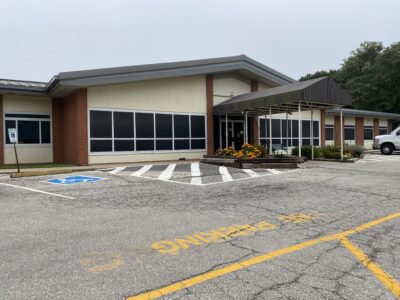Douglas County will see steep drop in rent and utility assistance funding as statewide program ends

photo by: Austin Hornbostel/Journal-World
The Douglas County Human Services Building, 2518 Ridge Court, is pictured Tuesday, Sept. 6, 2022.
Although rent and utility assistance funding has flowed freely into Douglas County in the past year, the well of federal relief programs is drying up.
From March of 2021 to this month, the Kansas Emergency Rental Assistance program distributed just over $19 million in rent and utility assistance to Douglas County. But that program is ending, with the nonprofit Kansas Housing Resources Corporation shifting the program to a “hold phase” and distributing its remaining federal funding based on a final round of applications in early October. Without KERA funding, Douglas County’s local rent and utility assistance provider, the Housing Stabilization Collaborative, will be left with less than $1 million in available aid through the end of 2023.
Douglas County’s human services program manager, Gabi Sprague, said the county has done a pretty good job of making the most of the KERA program while it’s been around. Sprague, who is the facilitator of the HSC’s stabilization program, said Douglas County’s KERA payments accounted for 7.4% of the total payments doled out throughout the state. That’s a good amount, she said, relative to how much of Kansas’ population is in Douglas County, about 4%. The HSC coupled the KERA aid with about $1.6 million of its own funds.
“I think the HSC was pretty integral in informing people about the KERA program and working with people to get people connected to that (aid),” Sprague said. “I’m proud of social service agencies’ ability to get people connected to that resource while it existed.”
But moving forward will be more complicated. The HSC recently received $350,000 from the City of Lawrence’s Affordable Housing Advisory Board to help bolster its capacity for rent and utility assistance now that KERA is expiring, but that only brings its available funding pool through the end of 2023 to somewhere around $944,000.
Agencies like Sprague’s have seen this coming for a while. In September, Sprague told the Journal-World that she expected the KERA program would end by the end of the year, but she also felt that the county was fairly well-positioned to weather that storm.
This week, Sprague said that the $944,000 in funding was about seven times the amount of rent and utility assistance that would have flowed into the county in a typical year prior to the coronavirus pandemic. However, it’s also only 4.6% of what came into the community from March of 2021 until now, and she said that some people had begun to depend on those COVID-era support programs.
“What I find mildly disheartening is I feel the federal government created these emergency rental assistance programs and people started relying on them,” Sprague said. “KERA provided 18 months of assistance with a little bit of landlord administrative burden. It was really easy … for landlords and tenants alike. Landlords didn’t have to worry about tenants paying their rent, and tenants didn’t have to pay their rent, so it was really a win-win situation for everyone, and really the KERA program was pretty good as long as everyone stayed on top of it. A lot of people began to rely on that, and now that’s all being taken away.”
And with that, Sprague said she’s worried the decision to halt the federal Emergency Rental Assistance program will further exacerbate the housing crisis. She said that, coupled with stagnant wages, rising housing costs and other challenges, means there are “a lot of different factors coalescing” all at once. It’s stressful, to say the least, Sprague said.
But Sprague said she’s hopeful that the situation’s not as dire as it seems. She said the HSC recognizes that there’s not enough funding to go around, so it will continue its efforts to seek out more rent and utility assistance funding. That will mean reaching out to local resources like the Douglas County Community Foundation to see if there’s any interest from private donors in contributing to the fund.
Sprague said the HSC is also looking into developing a resource network for local agencies to help bridge the gap.
“All of these agencies were doing grants and things before to get rent and utility assistance, so if we can all have some shared language and, like, put together documents for people doing that sort of work, we can all pool our money together,” Sprague said.
More broadly, Sprague listed a number of other strategies that’ll be in play to mitigate the decreased funding pool moving forward — building relationships between landlords and tenants, looking at adjustments in budgets that can funnel more money toward human services, and making its process as accessible as possible for priority populations like seniors and the county’s Spanish-speaking population.
A lot of that will mean staying the course, Sprague said, and looking toward community members for feedback — and crossing some fingers that the federal government looks to put more money into the U.S. Department of Housing and Urban Development to fund programs like KERA moving forward.
“I think developing that ecosystem while continuing to develop the resources that we have is really the best option,” Sprague said.







